Buying ranch land can be a lucrative investment, but it’s essential to understand what you’re looking for before purchasing. Whether you’re an experienced buyer or new to the world of real estate, understanding how and where to purchase ranch land is essential to make the right decision.
In this article, we’ll cover all the basics of buying ranch land, from researching potential properties to closing on your new property. We’ll also guide common pitfalls that first-time buyers should avoid. Then, with intelligent planning and careful consideration, you can confidently purchase your dream piece of rural real estate—all without breaking the bank!
Research and Planning
Researching and planning for the purchase of ranch property is a critical step. Costs associated with research should be included in your budget plan. Plus, when considering land, it’s essential to understand local zoning laws and other regulations that may impact how you use the land.
Additionally, consider deed restrictions, potential environmental concerns, or any other issues affecting the property’s value before deciding. Acquiring such information can assist you in making an informed investment and guaranteeing a successful outcome. Ranch costs and location considerations are also crucial when choosing ranch land.
Location Considerations
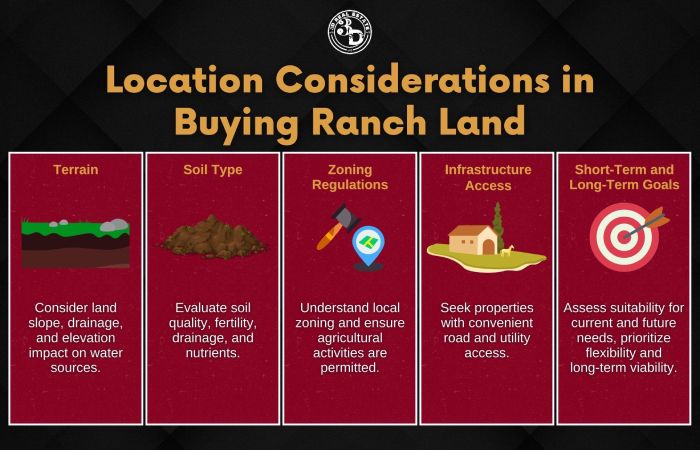
When you have finished conducting your research and making plans, it is crucial to consider the location of your ranch land. Here are some key indicators that should be taken into account:
- Terrain: Determine the type of terrain that would be most suitable for your ranch. Consider factors such as flat or sloping land, availability of natural drainage, and any elevation changes that could impact water sources or irrigation.
- Soil Type: Evaluate the soil quality and composition of potential locations. Different crops and animals thrive in different soil types, so choose land with soil that is well-suited to your agricultural plans. Conduct soil tests to assess its fertility, drainage, and nutrient content.
- Zoning Regulations: Understand the zoning regulations and land-use limitations in the area where you plan to purchase land. Ensure that agricultural activities are permitted and that no limits could hinder your plans for the ranch. Check with local authorities or consult a real estate professional familiar with the area.
- Infrastructure Access: Consider the availability and proximity of essential infrastructure. Look for properties with easy access to roads for transporting goods and livestock. Access to utilities like electricity, water, and sewage lines is also crucial for running a successful ranch.
- Short-Term and Long-Term Goals: Assess your current needs and plans for the ranch. If the chosen location only meets some of your requirements, consider whether it can be developed or adapted to meet your needs over time. Again, flexibility and long-term viability should be critical considerations.
Once you have thoroughly evaluated these factors and identified potential locations that meet your criteria, you can move on to budgeting and financing your ranch land purchase.
Budgeting and Financing Options
When purchasing ranch land, carefully considering your budgeting and financing options is essential. Understanding your financial situation and exploring various loan options will assist you to make an informed decision and secure the necessary funds. Here are the five common budgeting and financing options for buying ranch land:
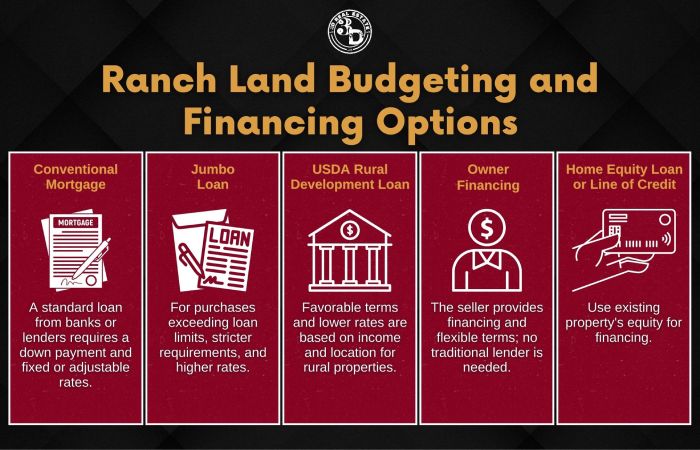
- Conventional Mortgage
It is a standard loan offered by banks and lending institutions, requiring a down payment (typically 20%) and offering fixed or adjustable interest rates.
- Jumbo Loan
If the purchase price surpasses the conforming loan limits set by government-sponsored enterprises, such as Fannie Mae or Freddie Mac, a jumbo loan may be necessary. It often involves stricter requirements and higher interest rates.
- USDA Rural Development Loan
The USDA offers loans specifically designed for rural properties, including ranch land. These loans may have favorable terms and lower interest rates, provided buyers meet certain income and location criteria.
- Owner Financing
Some sellers may offer financing directly to the buyer, allowing for more flexible terms. This arrangement eliminates the need for a traditional mortgage lender. Still, the times and interest rates can vary based on the agreement.
- Home Equity Loan or Line of Credit
If you already own a property with significant equity, you may think about using a home equity loan or line of credit to support your ranch land purchase. These loans leverage the equity in your current property as collateral.
By exploring these budgeting and financing options, you can choose the approach that aligns with your financial capabilities and objectives. Remember to thoroughly compare interest rates, terms, and eligibility criteria from different lenders to find the best solution for your needs when you plan to buy ranch land.
Understanding Property Rights

Once you have determined a budget and financing options, it is essential to understand the legal rights associated with purchasing ranch land. Knowing how ownership works, what zoning laws are in place, and more can help secure your land purchase.
When it comes to property rights, knowledge is power. Landowners should know all their legal rights regarding the land they buy. For example, knowing who owns the surface and mineral rights on any piece of land; otherwise, you may be in an unpleasant situation. Additionally, familiarize yourself with local zoning regulations so you don’t run into problems if you plan on building structures or making other changes to the land after closing.
It’s also wise to educate yourself about applicable taxes, such as agricultural use or timber production tax, before signing anything when buying ranch land. Property taxes can vary greatly from state to state, county to county, and even parcel by parcel — make sure you research! With this information, buyers will be better prepared for surprises during inspections and appraisals.
Inspections and Appraisals
When it comes to buying ranch land, inspections and appraisals are an essential part of the process. Therefore, it is crucial to comprehend the elements encompassed by both options to make an informed choice when buying your property.
Inspections help buyers identify any issues with the property before they purchase it. Essential components for inspecting ranch land include:
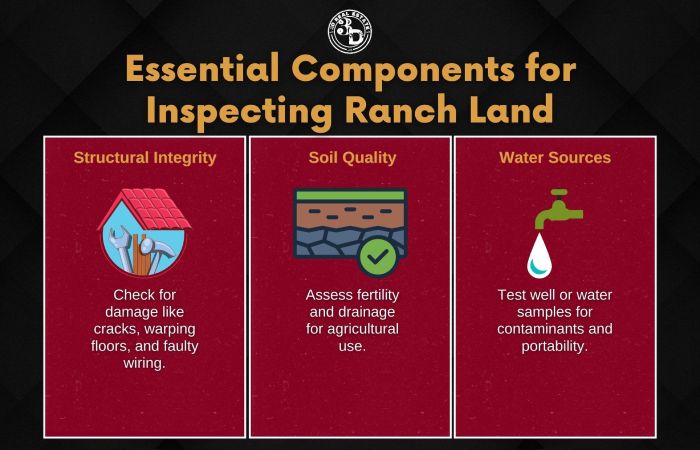
- Structural integrity – checking for signs of damage or wear, such as cracks in walls or ceilings, warping floors, faulty wiring, etc.
- Soil quality – evaluating soil fertility and drainage conditions to ensure optimal agricultural use.
- Water sources – testing water samples from wells or other bodies of water on the property to check for contaminants and potability.
Appraisals provide a calculation of the value of the ranch land by analyzing recent sales data in the area and assessing factors like location, size, utilities available, zoning restrictions, current market trends, and more. In addition, it helps potential buyers determine whether their offer price is reasonable given its condition and features. Key elements to consider during a ranch land appraisal include:
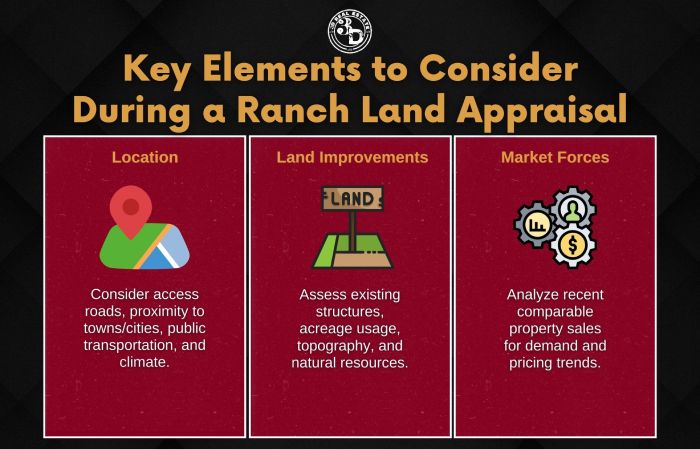
- Location – determining if access roads are present for easy transport; proximity to nearby towns or cities; availability of public transportation; climate considerations (e.g., temperature range), etc.
- Land improvements – considering existing structures like barns or fences; the acreage used/not used; topography; natural resources such as timberlands or mineral rights; etc.
- Market forces – looking at comparable properties that have recently sold to gauge the area’s demand levels and pricing trends.
Given how much money is typically invested in ranch land purchases, thorough inspections and appraisals are crucial in helping buyers make informed decisions about their investments when they plan to buy ranch land. With this information, buyers can confidently move forward with closing procedures, knowing all their questions have been answered satisfactorily.
Closing Procedures
Closing procedures in a real estate transaction involve several vital steps to ensure a smooth transfer of property ownership. Here is a classification of the typical closing procedures:
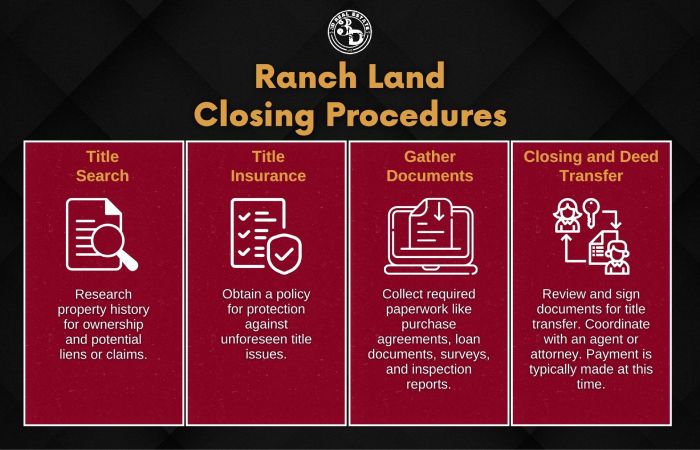
- Title Search
The first step in closing procedures is a title search. It involves researching the property’s history to ensure no liens, liabilities, or other claims that could hinder the sale. In addition, the title search helps establish clear property ownership.
- Title Insurance
If any potential issues or problems arise during the title search, the parties involved may need to obtain a title insurance policy. Title insurance protects against any unforeseen claims or defects in the title that may arise.
- Gathering Necessary Documents: Once the title search is completed and any title issues are resolved, all the necessary documents for the closing process must be collected. These documents typically include the purchase agreement, loan documents, property survey, inspection reports, and other relevant paperwork.
- Closing and Deed Transfer
The final step in closing procedures is the closing meeting. The buyer and seller and their respective real estate agents or attorneys come together to review and sign the required documents. It includes the deed, which officially transfers the ranch land title from the seller to the buyer. Coordinating with a real estate agent during this process can help facilitate the transaction, provide guidance, and ensure that all required documents are completed accurately. Payment is typically made at this time as well.
After the closing meeting, the transaction is considered complete, and the buyer becomes the new ranch land owner. It’s essential for both parties to carefully review the agreements and documents before signing, as they are legally binding contracts.
The Bottom Line
Buying ranch land is a significant investment, and it’s essential to do your research before jumping in. Take the time to consider location, budget, and financing options, understand property rights, and have inspections done. After all these actions are taken care of, you’ll be ready for closing procedures. It can feel overwhelming initially, but with proper planning, you can find the ideal piece of ranch land that fits your needs and budget. Once you’ve seen it, following the appropriate steps will help ensure a smooth closing day.
At 3D Real Estate, we recognize the significance of investing in ranch land and the importance of thorough research. Our group of experienced professionals is available to guide you through the entire process, covering everything from identifying suitable locations to exploring financing alternatives and understanding property rights. So contact us today and commence your journey toward owning the ranch of your dreams.




